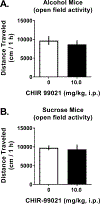Pharmacological inhibition of glycogen synthase kinase 3 increases operant alcohol self-administration in a manner associated with altered pGSK-3β, protein interacting with C kinase and GluA2 protein expression in the reward pathway of male C57BL/6J mice
- PMID: 31503067
- PMCID: PMC6954298
- DOI: 10.1097/FBP.0000000000000501
Pharmacological inhibition of glycogen synthase kinase 3 increases operant alcohol self-administration in a manner associated with altered pGSK-3β, protein interacting with C kinase and GluA2 protein expression in the reward pathway of male C57BL/6J mice
Abstract
Glycogen synthase kinase 3 (GSK-3) is a constitutively active serine-threonine kinase that regulates numerous signaling pathways and has been implicated in neurodegenerative and neuropsychiatric diseases. Alcohol exposure increases GSK-3β (ser9) phosphorylation (pGSK-3β); however, few studies have investigated whether GSK-3 regulates the positive reinforcing effects of alcohol, which drive repetitive drug use. To address this goal, male C57BL/6J mice were trained to lever press on a fixed-ratio 4 schedule of sweetened alcohol or sucrose-only reinforcement in operant conditioning chambers. The GSK-3 inhibitor CHIR 99021 (0-10 mg/kg, i.p.) was injected 45 minutes prior to self-administration sessions. After completion of the self-administration dose-effect curve, potential locomotor effects of the GSK-3 inhibitor were assessed. To determine molecular efficacy, CHIR 99021 (10 mg/kg, i.p.) was evaluated on pGSK-3β, GSK-3β, protein interacting with C kinase (PICK1), and α-amino-3-hydroxy-5-methyl-4-isoxazolepropionic acid (AMPA) receptor GluA2 subunit protein expression in amygdala, nucleus accumbens (NAcb), and frontal cortex. Results showed that CHIR 99021 (10 mg/kg) dose-dependently increased alcohol reinforced responding with no effect on sucrose self-administration or locomotor activity. CHIR 99021 (10 mg/kg) significantly decreased pGSK-3β expression in all brain regions tested, reduced PICK1 and increased GluA2 total expression only in the NAcb. We conclude that GSK-3 inhibition increased the reinforcing effects of alcohol in mice. This was associated with reduced pGSK-3β and PICK1, and increased GluA2 expression. Given prior results showing that AMPA receptor activity regulates alcohol self-administration, we propose that signaling through the GSK-3/PICK1/GluA2 molecular pathway drives the positive reinforcing effects of the drug, which are required for abuse liability.
Conflict of interest statement
All authors declare that they have no conflict of interest.
Figures





References
Publication types
MeSH terms
Substances
Grants and funding
LinkOut - more resources
Full Text Sources
Medical

